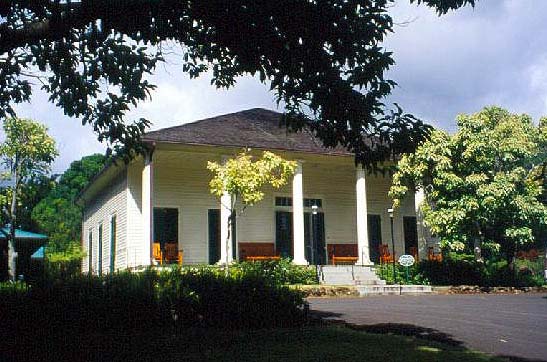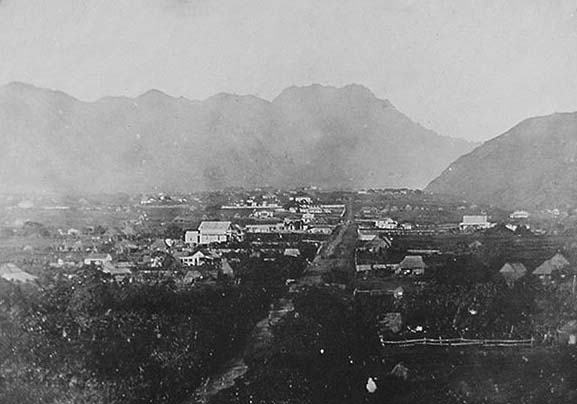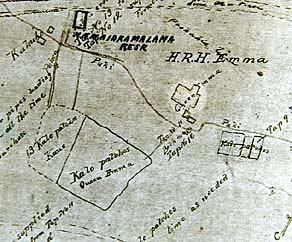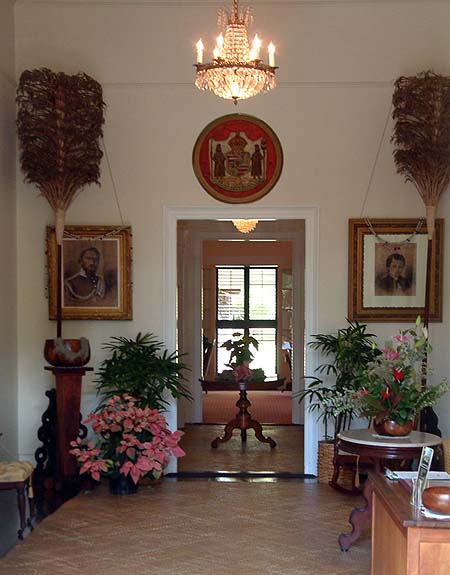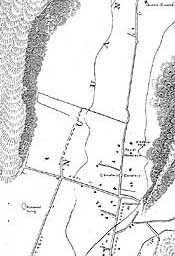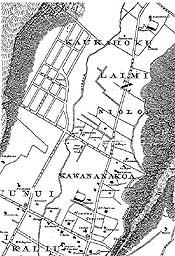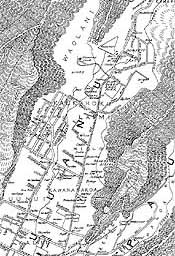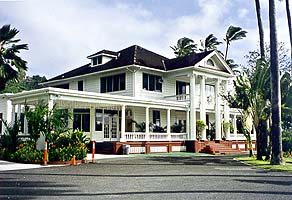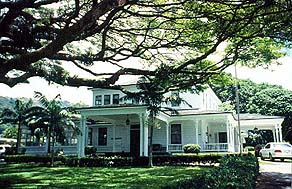 |
 |
 |
|||||||||||||||||||||
|
|
|
|
|
|
|
|
|
||||||||||||||||
|
|
|||||||||||||||||||||||
| |
|
|
|
|
Nu‘uanu had been the home to Hawaiian chiefs and royalty for a long time, and continued to be so. But in the aftermath of the Mahele, with land now privatized, lower and then central Nu‘uanu became popular locations for many wealthy non-Hawaiian businessmen to establish their homes. The cooler uplands of Nu‘uanu were far more comfortable than the hot plain of Honolulu, and the easy proximity just uphill from the government and commercial center of the islands made Nu‘uanu an ideal residence. The result is a landscape of large and gracious homes, many of which remain today, albeit not always as homes.
|
||
|
|
||
|
|
||
|
|
|
Hanaiakamalama, or Queen Emma's Summer Palace, is the only remaining royal residence, besides the ruins of Kaniakapupu. Built in Boston on the commission of an American ship captain and shipped around Cape Horn to Hawai‘i, the house was auctioned in 1850 and purchased by John Young II, Queen Emma's uncle. Queen Emma, wife of Kamehameha IV, was descended on her mother's side from John Young, Kamehameha I's British advisor who married Kamehameha's niece, and from high chiefs on her father's side. She was given as a hanai (foster child) to be raised by her mother's sister, who was married to an Englishman. Consequently, Emma received both Hawaiian and English upbringing.
|
|
|
|
The site of Hanaiakamalama, near Pu‘iwa, is thought by some to have formerly been a heiau. Kalani states, "from listening to people, I understand that when Kamehameha would come, because the area was planted in lo‘i and ‘uala, it was about this area that he would turn and look down the valley. So if this was a stopping off place, then there probably would have been a heiau, to mark the spot or to conduct ceremonies and rituals--because it was so much a part of daily life. You didn’t go to church on Sunday for two hours; Hawaiian spirituality was incorporated throughout the whole day, from when you awoke. Maybe not in front of strangers, but certainly in private." After Queen Emma's death in 1884, the house was purchased by the Hawaiian government and rented out. It was slated for demolition under the Territorial government in the early 1900s, but a group of women came together as the Daughters of Hawai‘i and has since been maintaining and preserving the property as a museum. They have retrieved many of Queen Emma's family's possessions, and re-established Hanaiakamalama as a royal residence in Nu‘uanu.
|
|
|
|
|
|
||
|
|
|
At the time of its founding, Hanaiakamalama was one of very few established residences in central Nu‘uanu. This does not mean that people were not living up there. It was common for Western-trained map-makers and writers to catalogue only Western-style homes as "residences," ignoring what were referred to as the "grass houses of the Hawaiians." The expansion of these "residences" up into Nu‘uanu took place largely after the overthrow of the Monarchy, as the haole government set about to "develop" Honolulu. The three maps below show this development. Click on the image to see a larger version. You will see that the names on the residences belong to many prominent Western businessmen. |
|
1887 |
1897 |
|
|
|
||
|
"Many of the old homes were acquired and turned into consulates," Kalani says. "I think it’s the only place that had the look of a stately mansion or place for a consulate. And they could easily take them and adapt them because they were on large pieces of property. Such a home was large and could easily be used by staff, and they could put a gate, if it didn’t already have its own gate. So these homes adapted easily to that use." Stephen points out that even during the Kingdom, Hawai‘i hosted diplomats from all over the world. The consulates are a carry-over from that.
|
|
|
|
"A lot of the large homes are gone now," Kalani continues. "When they widened the road, they took many people's front yards and put in stone walls. For instance, there's what used to be the Wilcox home that became the Walker home. When grandmother Una Walker died, a Japanese company bought it and used it as a retreat. "Another home was bought by a Japanese sect. The families moved, and when they moved, what they say is “we can’t afford to keep up the house anymore.” But what they are saying to the rest of us and to the environment is, it’s changing and I’m leaving, and I’m going to go somewhere else, or more convenient, or I’m going to travel, or my family is smaller, I’m doing something else. And they leave it up for grabs."
|
|
|
|
|
"It says to me they don’t have ties anymore or they don’t want to keep those ties anymore. I find that truly regrettable. They’re also not Hawaiian; they are not Hawaiians who are doing that, literally. I think that there’s hope that the few Hawaiian families that live here and others who might be interested will take up the challenge of trying to not let it become urbanized here." "We were one of the few Hawaiian families up here in Nu‘uanu," Kalani concludes, "and we still are. And actually we never talked about it much except amongst ourselves. It would probably make the non-Hawaiian families feel uncomfortable. Why were we concerned about their feelings, I don’t know, but generally we were." Kalani tells us more about life in Nu‘uanu in the next page, Growing Up.
|
||
|
|
||
| |
| |
|
|
 |
| Nu‘uanu Home | Map Library | Site Map | Hawaiian Islands Home | Pacific Worlds Home |
|
|
|||
| Copyright 2003 Pacific Worlds & Associates • Usage Policy • Webmaster |
|||
